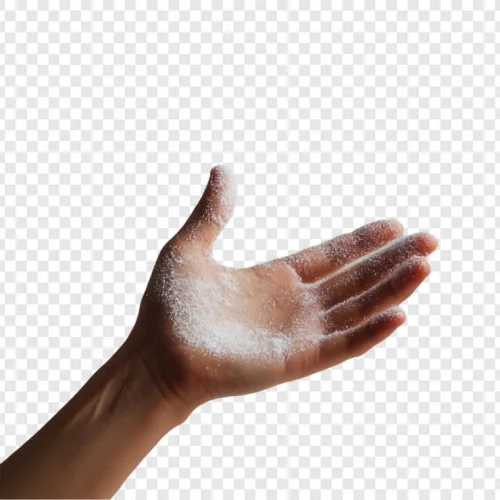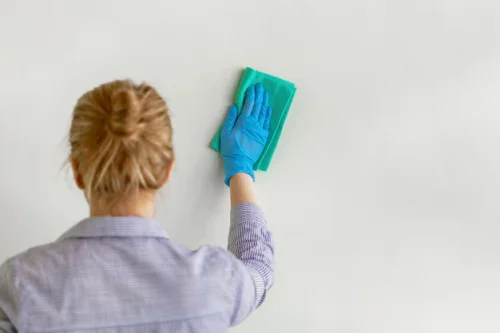
Exploring Aluminium Section Window Designs, Types & Advantages
April 7, 2025
The Ultimate Guide to Vertical Garden Plants for Your Home
April 8, 2025Have you ever noticed a white, powdery residue on painted walls or furniture? And, when you touch the surface, the powder transfers to your hand or clothes. This isn’t normal. It's a sign of paint chalking. Paint chalking not only dulls the appearance of painted surfaces but also weakens the surface underneath.
If you're seeing signs of paint chalking or planning to repaint, this guide will help you understand what causes it, how to fix it, and the best ways to prevent it.
What Is Paint Chalking?
Paint chalking occurs when a painted surface develops a fine, powdery residue due to the gradual breakdown of its binder, which holds the paint together. Overtime factors like UV exposure, moisture, and low-quality materials cause the binder to deteriorate, release pigment particles and leave behind a faded and dusty appearance.
While paint chalking is common, it’s not just a cosmetic issue. If it is ignored it accelerates more surface damage and causes peeling and cracking. But the good news is that with the right approach, you can restore affected surfaces and prevent future chalking.
What Causes Paint Chalking?
Several factors contribute to paint chalking:
- Sun Exposure – Too much direct sunlight breaks down the paint’s binders, causing it to chalk faster.
- Low-Quality Paint – Paint with weak binding agents tends to deteriorate more quickly.
- Moisture and Humidity – High humidity, rain, and condensation weaken the paint structure, leading to chalking.
- Poor Surface Preparation – Painting over dust, grease, or an already chalking surface without priming shortens the paint’s lifespan.
- Aging Paint – Over time, even high-quality paint starts to degrade.
- Harsh Cleaning Methods – Pressure washing or using strong cleaners can strip away the top layer of paint, accelerating chalking.
How to Identify Chalking Paint Defects
Try these simple tests to check if your paint is chalking:
- Hand Test: Run your hand over the surface. If you see a powdery residue on your fingers, that’s a sign of chalking.
- Water Test: Spray a little water on the area. If the paint washes away or turns milky, it’s time to take action.
How to Fix Emulsion Paint Chalking
If your walls show signs of chalking, follow these steps to restore them:
1. Clean the Surface
Start by removing the chalky residue. Use a soft brush, sponge, or low-pressure washer to clean the surface. For stubborn buildup, a mild detergent solution can help. Let the surface dry completely before proceeding.
2. Assess the Damage
If the chalking is mild, cleaning and repainting may be enough. But if the damage is extensive, you must check for flaking or peeling paint which indicates that additional prep work is necessary.
3. Apply a High-Quality Primer
A bonding primer helps seal the surface and prevent further chalking. This step ensures the new paint adheres properly. Choose a primer suited for the specific surface you are painting.
4. Select the Right Paint
Opt for a high-quality, weather-resistant paint with strong binders and UV protection. Avoid low-cost paints, as they tend to develop chalking defects more quickly.
5. Ensure Proper Application
Follow best painting practices like applying at least two coats, using a roller or sprayer for even coverage, avoiding extreme temperatures during application.
How to Prevent Paint Chalking Issues
Although all paint deteriorates over time, you can slow down chalking and extend its lifespan with these simple steps:
- Use Advanced Paints – Modern formulations with self-cleaning or dirt-resistant properties help reduce chalk buildup.
- Apply a Protective Coating – A clear sealant or nanocoating adds a layer of UV and weather resistance.
- Maintain Good Ventilation – Reducing indoor humidity, especially in kitchens and bathrooms, helps prevent moisture-related chalking.
- Choose the Right Paint for Your Climate – Some paints are designed to withstand extreme temperatures, humidity, or sunlight, offering better durability.
- Check for Wear Regularly – Catching early signs of chalking allows for minor touch-ups before major repainting is needed.
The Impact of Paint Chalking on Different Surfaces
Chalking affects various surfaces differently, so it's essential to take a different approach to prevention and maintenance. Here’s how different materials react to chalking and what you can do to protect them:
1. Exterior Walls
Outdoor walls are constantly exposed to sunlight, rain, and fluctuating temperatures which makes them susceptible to chalking.
Solution: Use high-quality acrylic or elastomeric exterior paint for better durability and resistance to environmental wear.
2. Interior Walls
Interior walls in moisture-prone areas like kitchens and bathrooms can speed up chalking.
Solution: Use moisture-resistant paint to help prevent chalking and maintain the paint’s finish.
3. Metal Surfaces
Chalking on metal surfaces can lead to rust and corrosion if left untreated.
Solution: Apply a rust-inhibiting primer before repainting to create a protective barrier and extend the lifespan of the paint.
4. Wooden Surfaces
Wood is naturally porous, absorbs moisture and it weakens paint adhesion and leads to chalking or peeling over time.
Solution: Seal the wood before painting to improve adhesion and extend the paint’s lifespan.
Time to Address Paint Chalking
Paint chalking isn't just a cosmetic issue—it's a sign that your paint is breaking down. Whether it's happening on your home's exterior or indoors, knowing the causes and how to fix it can save you from expensive repairs.
While maintaining your house, don’t forget to enhance its look with uPVC doors and windows from Greenfortune.
FAQ
1. Can you remove paint chalking without repainting?
Sometimes. Washing with mild detergent can reduce chalking, but if the paint is too worn, repainting is the best solution.
2. How long before paint starts chalking?
Paint chalking duration depends on paint quality and environmental conditions. Low-quality paint can chalk within a few years, while high-quality options can last over a decade.
3. Is chalk paint the same as paint chalking?
No. Chalk paint is a decorative finish used for furniture and home décor, while paint chalking is an unwanted deterioration that leaves a powdery residue.
4. Can you paint over chalking paint?
Yes, but you need to prepare the surface properly before starting the fresh quote.






